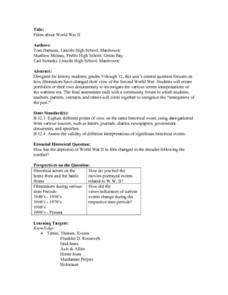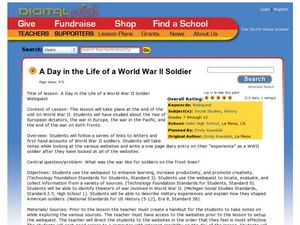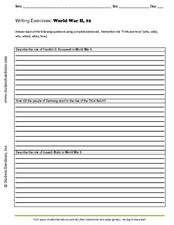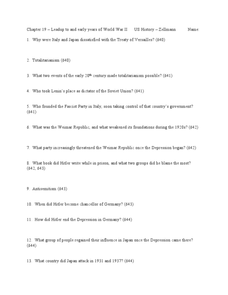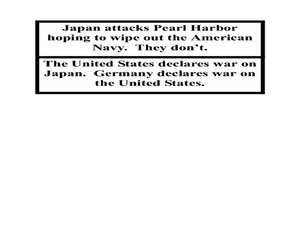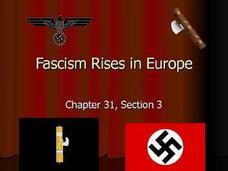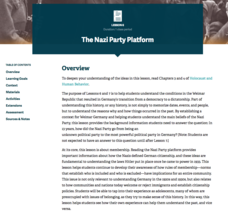Curated OER
Films About World War II
Ninth graders focus on how filmmakers have changed their view of the Second World War. They create portfolios or their own documentary to investigate the various screen interpretations of the wartime era and explain different points of...
Curated OER
World War II
Almost every big city has a war memorial, and many have memorials specific to WWII. This is a preparatory lesson for learners going on a trip to visit a local war memorial site. They are introduced to WWII through a simple time line of...
Curated OER
World War II Begins
Studying World War II? Explore the major incidents and factors leading to America entering the war with this history PowerPoint. Topics are broken into easy to follow points and cover content such as, the Depression, Nazi Party, Hitler,...
Curated OER
A Day in the Life of a World War II Soldier Webquest
Students complete a web-quest into a day in the life of a World War II soldier. In this webquest lesson, students investigate what life was like for soldiers on the front lines during the second World War. They use note taking skills...
Curated OER
World War II
Students research World War II and discuss how conflicts in the war lead to change. In this World War II lesson plan, students read books, watch movies, complete activity sheets, and answer questions all researching the war.
Curated OER
Writing Exercises: World War II, #2
Comprehending the role of key players and events of WWII is a task all learners must undertake. Here, they respond to three critical thinking questions regarding the roles Roosevelt and Stalin played during the war as well as Germany's...
Facing History and Ourselves
The Weimar Republic: Historical Context and Decision Making
Did you know that way before Hitler became a dictator, he actually spent nine months in a German jail? Provide the background for the escalating point before the Nazi party took over in World War II through the exercises in the resource....
Curated OER
Beginning of World War II
Ninth graders explore how the rise of dictators led to the start of World War II. They identify and explain the main causes for World War II and they explain the causes for the rise of dictators during the 1920's.
Curated OER
Chapter 26 – World War II
For this World War II worksheet, students read assigned textbook pages regarding the war and respond to 104 short answer questions.
Curated OER
Chapter 19 – Leadup to and Early Years of World War II
In this U.S. history worksheet, students read assigned textbook pages that describe the involvement of the U.S. in World War II and respond to 48 short answer questions.
Curated OER
Causes of World War II
In this World War II worksheet, learners view a PowerPoint presentation on the war and then respond to 82 short answer questions about the content of the presentation. The PowerPoint presentation is not included with this worksheet.
Curated OER
World War I and World War II Timeline Cards
For this World War I and World War II chronological events worksheet, students examine the timeline cards. The cards may be cut out so that students may study the chronology of events.
Curated OER
WWII
As a review of information learned about Word War II, this would be a great resource. In a format using pictures, diagrams and lists of information, the presentation provides a look at the key topics. Both visually attractive and...
Curated OER
Illingworth Cartoons: The Second World War
In this political cartoon analysis worksheet, students examine a political cartoon from the World War II era and respond to 4 short answer questions about it.
Curated OER
Fascism Rises in Europe: Ch 31
Help your class understand how Hitler achieved power prior to World War II. A strong presentation outlines the post-World War I social and economic context that primed Eastern Europe for a totalitarian dictator. It presents the...
Facing History and Ourselves
Life for German Youth in the 1930s: Education, Propaganda, Conformity, and Obedience
The German youth faced an onslaught of propaganda when they went to school, thanks to the Nazi regime led by Hitler during World War II. Pupils relate their education experiences to German youth by analyzing primary source readings,...
Curated OER
WW II Names and Faces
In this social studies instructional activity, students find the terms that are related to the people and events of World War II. The answers are found at the bottom of the page.
Facing History and Ourselves
The Nazi Party Platform
Not all party platforms stay democratic. A resource covers many political issues in Germany during the time of World War II, and teaches pupils about the Nazi party platform and what went wrong. Individuals participate in a warm-up...
Facing History and Ourselves
Laws and the National Community
When it comes to the law, is justice always served? Teach scholars about how law sometimes enables prejudice of entire groups of people with a unit on World War II that includes a warm-up activity, analysis of primary sources,...
Curated OER
Appeasement Student Worksheet
In this World War II worksheet, learners read a 1-page selection about Appeasement as well as Internet articles about the topic and then respond to 7 short answer questions.
Curated OER
AGGRESSION Comprehension Worksheet
In this World War II worksheet, students respond to 10 short answer questions regarding aggression of countries that feature the letters of the word "aggression" as mnemonic hooks.
Curated OER
Non-Violence Means "Doing Nothing"
Students reflect on violence and non-violence. In this World History lesson, students read an article by Gandhi then write an essay as to whether they agree or disagree with his thoughts. Students then share all their ideas as a class.
Curated OER
Julius Caesar
Famous Dictators and their main traits are listed on each slide in this Julius Caesar presentation. Important facts and events from each leaders' life accompany a picture which will keep your students' attention. There are some facts out...
Curated OER
Cartoons for the Classroom: The Political Dr. Seuss
In this historical events worksheet, students analyze political cartoons by Theodor Geisel. Students respond to 2 talking point questions.


